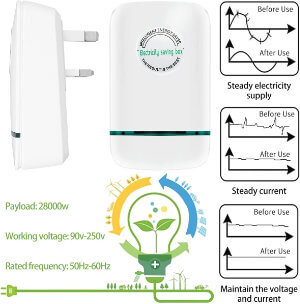Power Saver Plugs


Some more examples of power saving plugs being sold on Amazon here
KEY TAKEAWAYS
- Plug-in energy saving devices will not reduce your household electricity bill
- These energy saving devices are a scam
- Independent tests have shown these devices have serious safety defects
Power saver plugs claim to reduce your household electricity use by simply plugging the device into a socket. The description of how these devices operate is usually vague and they often use nonsense terms like ‘straightening the current’, or ‘cleaning the dirty voltage’. Sometimes they may also mention ‘balancing current’ and using capacitors. Like all good scams, there is a grain of truth behind this. The principle they appear to be based on is Power Factor Correction. Power factor correction is a genuine method of reducing electricity bills for commercial and industrial consumers. Unfortunately, these scam devices will not make any savings on your household electricity bill.
Domestic Electricity Bills
Power factor correction will never reduce household electricity bills. Domestic customers are only ever charged for Real Power, measured in kW or kilowatts. The power factor of the load does not affect your electricity bill and using a power factor correction device will not make any difference to the amount of electricity you are charged for.
Commercial Electricity Bills
Commercial and industrial customers are charged differently for electricity use than domestic customers. Commercial electricity usage is based on Apparent Power, measured in kVA or kilo volt-amperes. Essentially this means that they are charged more if the equipment they use causes the current and voltage to become out of sync (out of phase). Industrial equipment that generates a magnetic field to operate, such as motors and transformers, causes the current to lag behind the voltage. By adding capacitors to the system, the current can be brought back in sync with the voltage. This is referred to Power Factor Correction and is done to reduce the amount of power they are charged for. Power factor correction requires the careful selection of capacitors to match the load on the system. This article by the IET gives a great technical explanation of Power Factor Correction.
Safety Concerns
Electrical Safety First, the electrical safety charity, commissioned a series of independent electrical safety and performance tests on a number of these energy saving devices. The investigation revealed serious safety hazards for all the products tested. You can download the full report from the Electrical Safety First website.
Voltage Optimisation
These scam energy-saving devices should also not be confused with voltage optimisers. Voltage optimisation is a method of potentially reducing electricity bills by regulating the supply voltage. The official mains voltage in the UK is 230V, although most homes and businesses are still supplied at 240V, the pre-1995 standard. Voltage optimisers work by regulating the supply voltage to 230V. They are usually installed between the electricity meter and the consumer unit and will therefore need to be fitted by a qualified electrician. Voltage optimisation is most effective on inductive loads such as motors, pumps and fans, where energy savings can be potentially made. There is a great Wikipedia article on Voltage Optimisation.